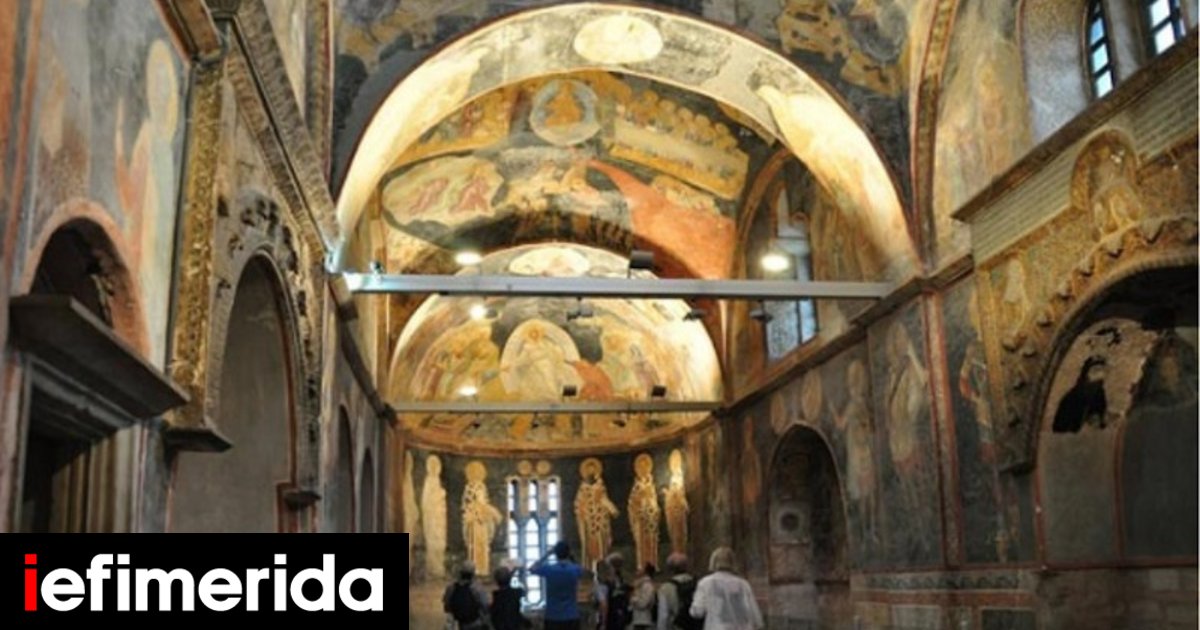
The opening of Chora Monastery as a mosque aroused natural reactions from the Greek side.
It is noteworthy that Turkish President Recep Tayyip Erdogan, yesterday, Easter Monday, inaugurated the operation of the monastery as a mosque in a special ceremony.
Erdogan: During the past 21 years, we have restored 5,500 ancestral monuments in our country.
“In the past 21 years, we have restored 5,500 ancestral relics in our country and throughout the geography of our heart,” the Turkish President said characteristically in his opening speech at the opening ceremony.
Recep Tayyip Erdogan continued: “I see this important ceremony today as another sign of the sensitivity we show regarding the protection of heritage.” When his turn came at Hora Monastery, he gave the floor to the Mufti of Istanbul Province, Safi. Arpagios who said: “Mr. President, after 79 years, it is being restored and reopened to the faithful by the General Directorate of Institutions. “Kariji” was converted into a museum 79-80 years after Hagia Sophia Mosque. This is a place that was used as a mosque before. This mosque, which became a museum after 1947, was renovated and repaired with the efforts and support of our institutions, and today, with God’s help, it will once again be dedicated to prayer and receiving believers in Istanbul.
Then the Turkish President gave the order to cut the inauguration ribbon: “The scissors are in your hands and the ribbon is in front of you. Let us all say “In the Name of God” (In the Name of God) and cut the ribbon. Good luck!”
The mosaics on the walls were covered
The mosque will be modeled after Hagia Sophia. The mosaics on the walls of the prayer area were covered, and an area was designated for tourists to visit with a guide.
Reactions of the Greek Ministry of Foreign Affairs regarding Chora Monastery
The Greek Ministry of Foreign Affairs issued an announcement regarding the operation of the Chora Monastery as a mosque, describing the relevant decision taken by the Turkish authorities as a “challenge to the international community.”
In its announcement, the Ministry of Foreign Affairs indicates the following:
“The decision of the Turkish authorities to start operating Chora Monastery as an Islamic mosque poses a challenge to the international community because it alters and denigrates its character as a UNESCO World Cultural Heritage Monument belonging to humanity.”
Preserving the universal character of monuments and taking into account international standards for the protection of religious and cultural heritage is a clear international obligation binding all states,” the Greek Ministry of Foreign Affairs concluded.
History of the Byzantine Monastery of Chora
The Church of Agios Sotiros in Chora, the Catholic church of what was once a monastic complex, dates back to the 6th century AD, while the unique mosaics and frescoes were created in the 14th century, from 1305 to 1320, during the reign of Palaiologos.
It is the monument containing the most elaborate Byzantine mosaics preserved in Constantinople, along with Hagia Sophia and the Pamakaristos Monastery, which also functions as a mosque called Fethiye. Hagia Sophia was also dedicated to Islamic religious worship in 2020.
Chora Monastery was converted into a mosque in 1511, 58 years after the fall of the city. However, by decision of the Turkish Council of Ministers, in 1945 it became a museum.
After this decision, specialists from the United States of America carried out huge work to restore and maintain the mosaics and frescoes, and remove the plaster that covered them. Work began in 1948, and was completed ten years later, in 1958.
But in 2019, the Turkish Council of State (Danistay) rescinded the 1945 decision, and a year later, President Erdogan announced that the memorial would once again serve as a mosque.

“Hipster-friendly coffee fanatic. Subtly charming bacon advocate. Friend of animals everywhere.”





More Stories
He is the “Hitler of our time.”
Woke Agenda: Infuriates Elon Musk, Burns Politicians, Targets the Secret Service
Panic after steam explosion in Yellowstone Park